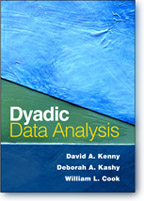|
May 15, 2010
|

|
Chapter 10
Corrections
On page 267, 5 lines from the bottom, the N in the formula should be lower case or n, as it is the number of focal persons, not the number of partners.
Clarifications
None so far.
Elaborations
Kashy and Kenny have written a handout that describes how the Reciprocal One-with-Many design can be analyzed using SPSS and other programs.
Handout
SPSS Data, SPSS Syntax, and SPSS Output
SAS Data, SAS Syntax, and SAS Output
HLM MDMT File, HLM HLM File, and HLM Output
MLwiN WS File
Two papers present analyses using the one-with-many design:
Marcus, D. K., Kashy, Deborah A., Baldwin, S. A. (2009). Studying psychotherapy using the one-with-many design: The therapeutic alliance as an exemplar. Journal of Counseling Psychology, 56, 537-548.
Kenny, D. A., Veldhuijzen W., Weijden T., Leblanc A., Lockyer J., Légaré, F., & Campbell C. (2009). Interpersonal perception in the context of doctor-patient relationships: A dyadic analysis of doctor-patient communication. Social Science and Medicine, 70, 763-768.
Data and Files
The different data files for the Cook data are:
Family Data (SPSS)
The AMOS runs for the reciprocal-indistinguishable are:
AMOS Setup and Amos Output (use family data)
Go to the top.
Go to the main page of the book.
|
